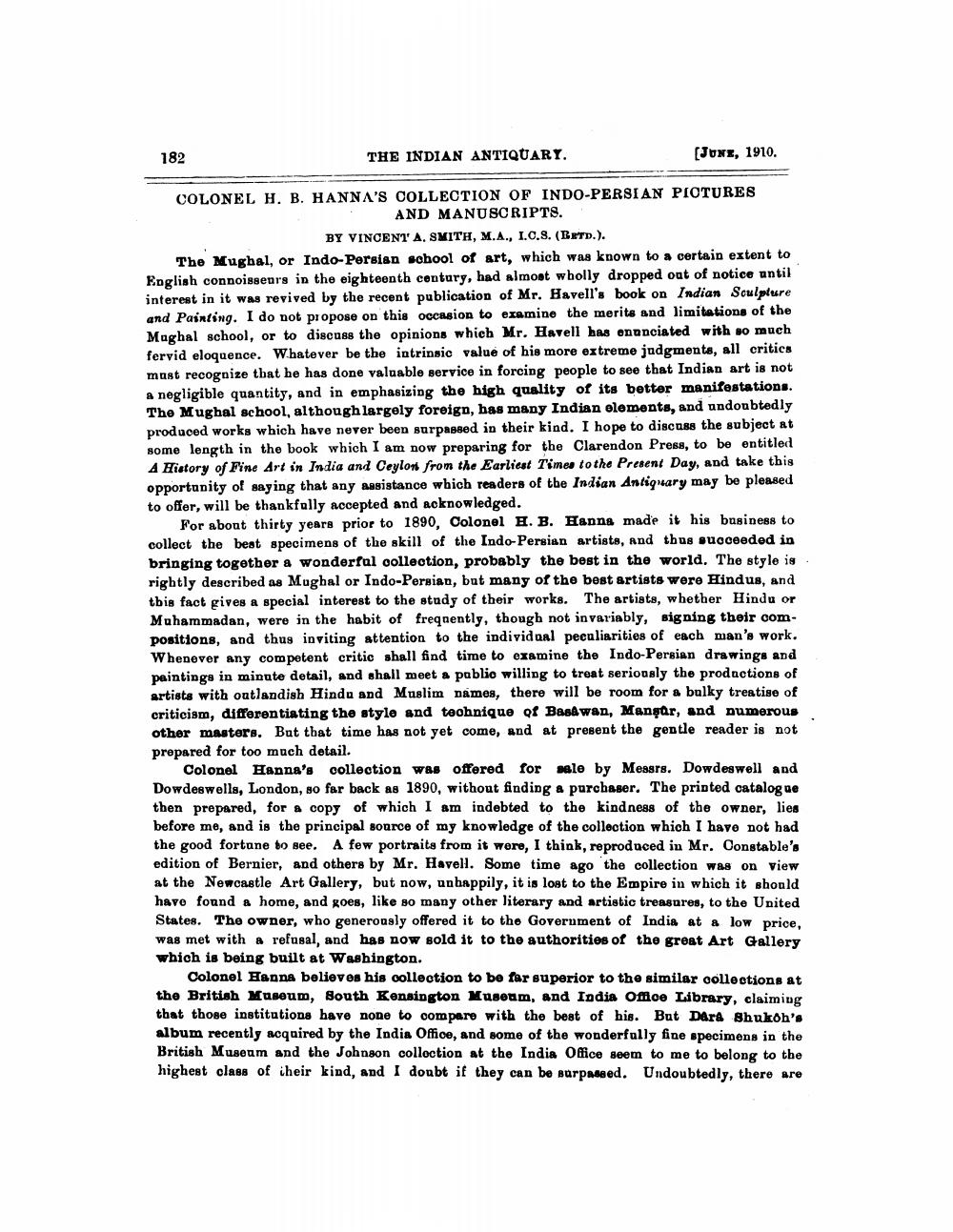________________
182
THE INDIAN ANTIQUARY.
[JUNE, 1910.
COLONEL H. B. HANNA'S COLLECTION OF INDO-PERSIAN PICTURES
AND MANUSCRIPTS.
BY VINCENT A. SMITH, M.A., I.C.S. (BETD.).
The Mughal, or Indo-Persian school of art, which was known to a certain extent to English connoisseurs in the eighteenth century, had almost wholly dropped out of notice until interest in it was revived by the recent publication of Mr. Havell's book on Indian Sculpture and Painting. I do not propose on this occasion to examine the merits and limitations of the Mughal school, or to discuss the opinions which Mr. Havell has enunciated with so much fervid eloquence. Whatever be the intrinsic value of his more extreme judgments, all critics must recognize that he has done valuable service in forcing people to see that Indian art is not a negligible quantity, and in emphasizing the high quality of its better manifestations. The Mughal school, although largely foreign, has many Indian elements, and undoubtedly produced works which have never been surpassed in their kind. I hope to discuss the subject at some length in the book which I am now preparing for the Clarendon Press, to be entitled A History of Fine Art in India and Ceylon from the Earliest Times to the Present Day, and take this opportunity of saying that any assistance which readers of the Indian Antiquary may be pleased to offer, will be thankfully accepted and acknowledged.
For about thirty years prior to 1890, Colonel H. B. Hanna made it his business to collect the best specimens of the skill of the Indo-Persian artists, and thus succeeded in bringing together a wonderful collection, probably the best in the world. The style is rightly described as Mughal or Indo-Persian, but many of the best artists were Hindus, and this fact gives a special interest to the study of their works. The artists, whether Hindu or Muhammadan, were in the habit of frequently, though not invariably, signing their compositions, and thus inviting attention to the individual peculiarities of each man's work. Whenever any competent critic shall find time to examine the Indo-Persian drawings and paintings in minute detail, and shall meet a public willing to treat seriously the productions of artists with outlandish Hindu and Muslim names, there will be room for a bulky treatise of criticism, differentiating the style and technique of Basawan, Manşar, and numerous other masters. But that time has not yet come, and at present the gentle reader is not prepared for too much detail.
Colonel Hanna's collection was offered for sale by Messrs. Dowdeswell and Dowdeswells, London, so far back as 1890, without finding a purchaser. The printed catalogue then prepared, for a copy of which I am indebted to the kindness of the owner, lies before me, and is the principal source of my knowledge of the collection which I have not had the good fortune to see. A few portraits from it were, I think, reproduced in Mr. Constable's edition of Bernier, and others by Mr. Havell. Some time ago the collection was on view at the Newcastle Art Gallery, but now, unhappily, it is lost to the Empire in which it should have found a home, and goes, like so many other literary and artistic treasures, to the United States. The owner, who generously offered it to the Government of India at a low price, was met with a refusal, and has now sold it to the authorities of the great Art Gallery which is being built at Washington.
Colonel Hanna believes his collection to be far superior to the similar collections at the British Museum, South Kensington Museum, and India Office Library, claiming that those institutions have none to compare with the best of his. But Dara Shukoh's album recently acquired by the India Office, and some of the wonderfully fine specimens in the British Museum and the Johnson collection at the India Office seem to me to belong to the highest class of their kind, and I doubt if they can be surpassed. Undoubtedly, there are




